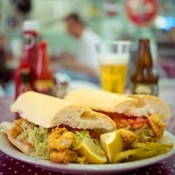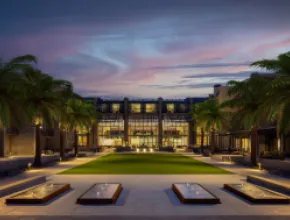Way before there was a Food Network or celebrity chefs, back when no one had ever heard the term “foodie” and Emeril Lagasse had yet to utter his first “Bam!,” Louisiana was obsessed with eating.
“Food is a way of life in Louisiana,” says noted Cajun chef Patrick Mould, owner of the Louisiana School of Cooking in Lafayette. “It is ingrained in our culture. We are usually talking about what we are going to have for our next meal while we are sitting down at the table eating the meal in front of us.”
This obsession is partly fueled by Louisiana’s incredible natural bounty—vast fields of rice and corn, pecan groves, game of all kinds, and even spices. Louisiana produces its own salt and sugar, not to mention dozens of locally bottled hot sauces, including the world-famous Tabasco. However, the star ingredient of Louisiana cooking is its seafood.
“Shrimp, crab, crawfish, and oysters—these four are what give our cuisine its unique edge,” says Carling Dinker of Custom Conventions in New Orleans.
Actually make that two cuisines. Unlike almost any other place in the U.S., Louisiana is home to two distinctive styles of cooking: Creole and Cajun.
“Cajun is a rustic style of cooking that was developed by the Acadians of Nova Scotia after they settled in Louisiana. It is based on hearty one-pot dishes like gumbo,” Mould explains. “Creole cooking is a more sophisticated city version developed in New Orleans and based on the European style of cooking.”
Trout meuniere amandine, oysters Rockefeller and shrimp Creole are delicious examples.
Cajun and Creole, both fusions of Old World and New World cooking, have blended into one another to become quite simply, Louisiana cooking.
When he sang “Jambalaya and crawfish pie and file gumbo,” Hank Williams was referring to Cajun Country, but these dishes are just as readily available throughout the state—from New Orleans and neighboring St. Tammany Parish and Jefferson Parish, to Baton Rouge, Natchitoches, Shreveport, and Monroe. However, the local menu goes beyond local flavors.
“It’s influenced by all the ethnic groups that have come together to shape the area itself—the French, Spanish, African, German, and Italian communities,” says Renee Kientz of the St. Tammany Parish Tourist and Convention Commission. “Golden-fried oysters, Sicilian stuffed artichokes, anise-scented cookies, savory olive-smothered muffulettas, and over-stuffed roast beef po’ boys so drenched in gravy the juice runs down your arm. That’s all Louisiana cooking.”
But beyond bounty and tradition, the real reason for Louisiana’s love affair with food is its association with celebration.
“Food isn’t just about surviving here, it’s about celebrating life,” says Brandy Claiborne of the Shreveport-Bossier City Convention and Tourist Bureau. “Food infuses our events, marks our holidays, and comforts our souls.”
For groups meeting in the state, this means culinary treasures and memorable gatherings go together as naturally as red beans and rice.
At the Table and on the Road
The easiest way for meeting planners to add the taste of Louisiana to events is simply to bring their guests to the table.
In New Orleans, classic Creole cuisine can be found at what Dinker calls the “Cathedrals of Creole Cooking”—Antoine’s, Arnaud’s and Broussard’s. All three can handle large groups (up to 1,000 at Arnaud’s), with the added plus of being authentic domains of Old New Orleans elegance.
For groups heading to Acadia, the famed Cajun Country stretching west of New Orleans to the Texas border, it’s got to be Cajun. The legendary Prejean’s in Lafayette offers award-winning cuisine—don’t miss the duck and andouille gumbo—along with kick-up-your-heels live Cajun music. Around Lake Charles, groups can get really authentic at local favorites like Steamboat Bill’s and Cajun Charlie’s.
The state capital, Baton Rouge, lets groups in on the Cajun action at the boisterous dining and dance hall Boutin’s.
If you’d rather give attendees a veritable gumbo of choices, New Orleans Culinary History Tours takes groups on an eating odyssey of the French Quarter, which includes a behind-the-scenes visit at Antoine’s, a muffuletta at the atmospheric Napoleon House, beignets at Cafe du Monde, and a stop at the working kitchen of a circa-1831 plantation house.
Dinker suggests dine-arounds for larger groups.
“We begin all together for a classic New Orleans cocktail like a Sazerac, then guests break off in small groups to dine at a variety of top New Orleans restaurants,” Dinker says. “Afterward, we meet up again for cafe brulot (flaming coffee and cognac).”
Mould takes smaller groups on the road.
“We literally eat our way from New Orleans to Lafayette, taking in some of my favorite restaurants,” Mould says. “We visit the Tabasco factory and dance in the honky-tonks at night. While in Lafayette, we do cooking classes and further explore Cajun and Creole cooking. You don’t leave hungry but you do leave with a first-hand understanding of the unique way of life we have in Louisiana.”
Chefs for a Day
Chefs, cooking schools and DMCs throughout the state offer a wide range of programs that let attendees get their hands on the pots and pans.
In New Orleans, The Savvy Gourmet runs a 4,500-square-foot cooking school in the Uptown District. Owner Aaron Wolfson says his most popular event is a multistation, interactive cooking class. Guests begin with a mint julep and an overview of Louisiana culinary history. They then split up into three groups, joining local chefs at individual stations to prepare Louisiana specialties. Finally, everyone comes back together for a dramatic presentation of the flaming New Orleans dessert classic bananas Foster.
The Savvy Gourmet also promotes “culinary voluntourism.”
“Groups do a cooking class at the school, then pack up the food and take it to one of the many sites where volunteers are still rebuilding homes,” Wolfson says. “There, cooks and volunteers eat together and learn about ongoing post-Katrina reconstruction efforts.”
The New Orleans Metropolitan CVB as well as several of the city’s larger hotels can also arrange culinary events that include a volunteer aspect.
Outside of New Orleans, chef John Folse runs a food empire that includes fine restaurants, a culinary institute and two gorgeous plantation houses near Baton Rouge. His team can arrange a wide variety of chef demos and events.
In Natchitoches, the area that set the scene for the film Steel Magnolias, chef Ben Fidelak of Maison-Louisiane Catering arranges Louisiana cooking experiences for groups in a lovely 19th century Queen Anne home.
Out in Cajun Country, the Louisiana School of Cooking offers a buffet of cooking events that can include everything from how to prepare a pot of gumbo to a crawfish boil complete with live zydeco music under the school’s moss-covered oak trees.
Everyone Loves a Louisiana Party
In a place as in love with food as Louisiana, there is no shortage of food events where groups have to do nothing more than show up ready to eat and looking for a good time.
Traditional events include the crawfish boil, a raucous, down-home celebration of Louisiana’s favorite crustacean that consists of boiling and consuming crawfish by the bucketful. Common throughout the state, but best during crawfish season from March to September, crawfish boils are put on by expert crawfish cooks who can be contracted through local seafood shops or CVBs.
Cochon de lait, a Cajun specialty of spit-roasted suckling pig, is also popular with groups. The tradition dates back to the old practice of boucherie, a winter butchering of hogs.
“Of course, Cajuns made a party out of everything, and so a tradition was born,” explains Alice Whiting of Acadia Tours.
Dinker suggests holding a cochon de lait on the lovely grounds of Laura Plantation, 60 miles outside of New Orleans.
“Top that with a jambalaya or etouffee, and don’t forget the bread pudding! Add some live zydeco music, and you have an authentic Louisiana party,” Dinker says.
Creative planners and celebrity chefs are also teaming up for food events from intimate to over the top. The Savvy Gourmet as well as the New Orleans Cooking Experience, housed in an 18th century Creole plantation just outside of the French Quarter, will arrange cooking demos by just about any top chef in New Orleans.
“These are really popular with spousal groups,” Wolfson says.
Mary Beth Romig of the New Orleans Metropolitan CVB recalls a spectacular party for the Allstate BCS National Championship football match.
“It started with a Mardi Gras parade featuring three of our top chefs: Emeril Lagasse, Susan Spicer and John Besh,” Romig says. “They threw beads with little plastic food items like onions, garlic, shrimp, and peppers. After the parade, they went to individual food stations and cooked food for the attendees and talked to the people face-to-face.”
The simplest way to incorporate a Louisiana food event into the meeting is to check the calendar.
“No one has more food festivals than Louisiana,” notes Katie Harrington of the Southwest Louisiana CVB.
From March to September, there is a festival every weekend. In New Orleans, the mother of all fests is the Jazz and Heritage Festival.
“The food operation there is unbelievable,” Wolfson says. “It is an amazing time to sample a lot of Louisiana cuisine at one time.”
In nearby Jefferson Parish, the bayou-bound community of Lafitte hosts the Oyster Festival, while nearby Gretna stages the Gretna Heritage Festival, complete with a hearty helping of local food specialties.
On the Northshore, across Lake Ponchartrain, the tiny town of Lacombe sponsors the Crab Festival.
Around Baton Rouge, groups can visit the Jambalaya Festival in Gonzalez and the Strawberry Festival in Ponchatoula.
In Cajun Country, Breaux Bridge offers the Crawfish Festival, New Iberia hosts the World Championship Gumbo Cook-Off, Crowley has the Rice Festival, and Lake Charles holds the Cajun French Music and Food Festival.
In central and northern Louisiana, look for the Shreveport Mudbug Madness and the Natchitoches Meat Pie Festival.
The list goes on, and planners can check the CVB websites for food festivals corresponding with their event. But be warned. Bringing your group to a local Louisiana festival is akin to dropping the kids off at a video game store. Faced with nonstop music and bottomless mounds of delicious food, they very well may not want to return to the meeting.
Hot on the Trail
Despite Louisiana’s unique food heritage, the state was slow to jump on the culinary tourism bandwagon. Seems that food is such a given round these parts, no one really thought of marketing it aggressively.
That changed in 2007, when a joint report by Gourmet magazine, the Travel Industry Association and the International Culinary Tourism Association identified Louisiana as one of the top 15 destinations for food-related travel in the country. In response, the state launched Louisiana’s Culinary Trails, a public-private initiative to map out culinary routes across the state—from restaurants to farms to food-related cultural attractions. Louisiana CVBs, restaurateurs and food producers are already busy planning tie-in events.
The Southwest Louisiana CVB, one of the sponsors of Louisiana’s Culinary Trails, has already begun.
“We recently hosted a culinary trip that included Cajun cooking demonstrations, a tour of the historic Crystal Rice Mill and Heritage Farm, a visit to a corner grocer to see where the locals shop, and some wonderful food,” says the CVB’s Harrington.
The Baton Rouge Area CVB, another sponsor, suggests food events like a 19th century cooking demonstration in the open hearth kitchen of Magnolia Mound Plantation or a visit to the lively Tony’s Seafood Market—“a destination in itself,” says Renee Areng, executive vice president of sales and marketing for the CVB.
In Cajun Country, Whiting and Acadia Tours are also gearing up. Calling the initiative “a great way to eat your way across Louisiana,” Whiting organizes group tours to a family-run rice and crawfish farm, where the farmer will prepare a giant pot of homemade gumbo for guests.
“Of course, around here food and music go together, so guests can also expect good Cajun music on the side,” she says. “Laissez les bons temps rouler!”
Practically a state motto, this French phrase means “let the good times roll”—exactly what event planners can expect when they invite their groups to the Louisiana table.
For More Info
Baton Rouge Area CVB 225.383.1825
www.visitbatonrouge.com
Jefferson CVB 504.731.7083
www.neworleansgateway.com
Kenner CVB 504.464.9494
www.kennercvb.com
Lafayette Convention and Visitors Commission 337.232.3737
www.lafayettetravel.com
Louisiana Office of Tourism 225.342.8100
www.louisianatravel.com
Monroe–West Monroe CVB 318.387.5691
www.monroe-westmonroe.org
Natchitoches Area CVB 318.352.8072
www.natchitoches.net
New Orleans Metropolitan CVB 504.566.5011
www.neworleanscvb.com
Ruston–Lincoln CVB 318.255.2031
www.rustonlincoln.com
Shreveport–Bossier City Convention and Tourist Bureau 318.222.9391
www.shreveport-bossier.org
Southwest Louisiana CVB 337.436.9588
www.visitlakecharles.org
St. Tammany Parish Tourist and Convention Commission 985.892.0520
www.louisiananorthshore.com
West Baton Rouge CVB 225.344.2920
www.westbatonrouge.net






